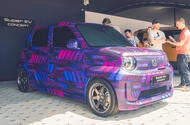What Makes the Honda Super EV Concept Stand Out Among City Cars?
Honda’s Super EV Concept isn’t just another electric hatchback vying for attention—it’s a bold statement about where city driving is headed. With its boxy silhouette and compact A-segment footprint, this concept car is Honda’s answer to the likes of the Hyundai Inster, Fiat 500e, and the soon-to-arrive Renault Twingo. But what really sets it apart? For starters, Honda has drawn inspiration from its much-loved Honda E supermini, blending retro charm with a modern edge. The result? A car that looks both familiar and refreshingly new, ready to turn heads on tight urban streets.
Is the Super EV Concept Just for Show, or Will It Actually Hit the Roads?
While Honda’s keeping most technical details under wraps, there’s more here than just a flashy prototype. The Super EV Concept has already been tested in the UK, signaling that Honda is serious about bringing an affordable, fun-to-drive electric city car to market. If it makes it to production, expect it to serve as the entry point in Honda’s growing EV lineup—slotting in below the more premium 0 Series models. This isn’t just a design exercise; it’s a glimpse at a practical, everyday EV that could soon be within reach for city dwellers.
How Does Honda’s Approach to Electrification Differ From Its Rivals?
Honda’s strategy stands out for its willingness to reset and rethink. Instead of simply electrifying existing models, the company is developing a brand-new platform, batteries, and motor technologies for its next wave of EVs. According to CEO Toshihiro Mibe, this shift comes as society moves from early EV adoption to a broader, mainstream embrace of electric vehicles. Honda’s plan? Launch seven new EVs in the coming years, each designed from the ground up to meet the evolving needs of drivers. This fresh start is a direct response to lessons learned from earlier models like the Honda E and the current e:Ny1.
Why Is Honda Still Investing in Hybrids Alongside EVs?
Here’s where Honda’s nuanced approach really shines. While many automakers are racing headlong into full electrification, Honda recognizes that not every market is ready to make the leap. That’s why the brand is doubling down on hybrids, with 13 new models set to launch globally by 2030. These hybrids will feature what Honda claims are the world’s most efficient combustion engines, providing a crucial bridge for drivers who aren’t quite ready to go all-electric. It’s a pragmatic move—one that acknowledges the real-world challenges of EV adoption, from charging infrastructure to cost.
What’s the Real-World Impact for Urban Drivers?
If you live in a city, you know the pain points: tight parking, stop-and-go traffic, and the growing pressure to cut emissions. The Super EV Concept is designed with these realities in mind. Its compact size makes it a breeze to maneuver and park, while its electric powertrain promises zero tailpipe emissions—perfect for low-emission zones popping up in cities worldwide. And with Honda’s focus on affordability and driving fun, this isn’t just a car for eco-conscious commuters; it’s one that could actually make city driving enjoyable again.
How Does the Super EV Fit Into Honda’s Broader Vision?
The unveiling of the Super EV Concept at the Goodwood Festival of Speed wasn’t just about one car—it was part of a larger showcase that included the radical 0 Series SUV and the Civic Type R Ultimate Edition. Honda is clearly signaling that its future will be a blend of electrification, performance, and design innovation. The Super EV, as the likely entry point to this new era, embodies Honda’s belief that small, accessible cars can still be exciting and relevant, even as the automotive world changes at breakneck speed.
The Big Takeaway for Anyone Eyeing a City EV
The Super EV Concept proves that the future of city driving isn’t about sacrificing fun for efficiency—it’s about finding the sweet spot where both meet. Honda’s approach shows that smart, adaptable strategies—like blending hybrids with new EV tech—can make the transition smoother for everyone. The big takeaway? Shifting to electric mobility isn’t about perfection—it’s about smarter adjustments. Start with one change this week, and you’ll likely spot the difference by month’s end.

